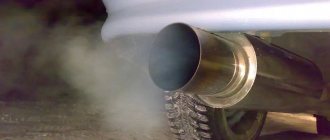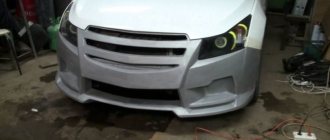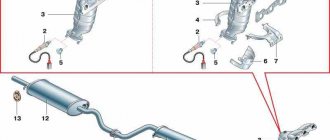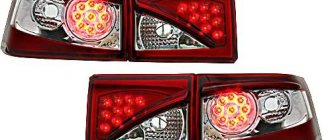The solution to many car problems is tuning. What are its main advantages, what varieties are there? What car improvements can you make yourself and how to do it? Tuning the exhaust system - recommendations, tips, conclusions on this topic.
Car tuning refers to procedures for improving it, modifications made to improve its professional qualities, as well as achieve comfort in use and a pleasant visual impression. Tuning has a very important feature - it should be done only for the benefit of the car, and not to the detriment of its existing characteristics.
Almost every person tunes their car. The reasons for the need for this may be different, for example, owners of cars of domestic brands most often need tuning due to dissatisfaction with the performance of their car. The reason for tuning more expensive cars is the owner’s desire to give his device a special style and a more pleasant appearance.
Some users also make improvements to old antique cars in order to update their qualities and be able to use them comfortably.
How to wrap it correctly?
The efficiency of operation depends on the quality of the winding. If you make a winding with errors, then there will be no benefit from it. Therefore, let's look at an example of using tape on an already modified exhaust system.
First of all, purchase thermal tape from reputable manufacturers. Cheap Chinese material often contains asbestos, which is not very good.
The optimal width is 40-50 mm.
You should not take one that is too narrow, its effectiveness is lower, and one that is too wide will be inconvenient to use.
The work is carried out in the following order:
- Treat the collector with heat-resistant, anti-corrosion paint, this will extend its service life;
- Before winding the tape, soak it in water for about an hour. In this case, it will not slide along the pipe and will be wound more smoothly;
- After winding one layer, secure it with metal clamps.
That's all the technology is. It is worth noting that only the trousers or the “spider” are wrapped, and only until the transition to a solid muffler. There is no need to wrap the entire muffler; the gases will cool down along its length anyway, and the winding will be ineffective.
We remake the muffler with our own hands
When choosing this tuning method, it is best to completely redo the exhaust system. To do this, purchase a pipe of the required size (most often its diameter is from 30 to 52 millimeters). Of course, the thin-walled tube that comes to the car from the factory will be very difficult to find. Therefore, we use thin-walled tap water as an analogue.
The housing for the muffler is made from a car fire extinguisher. Moreover, the outlet and inlet holes should be shifted relative to each other. The ends of thin-walled pipes should be inserted 60 percent inside the container. Numerous holes should also be made in them. As for partitions that are installed in factory versions, it is not necessary to weld them. Using the same principle, you can make a muffler for a carbine yourself.
Do-it-yourself welding of a new resonator
This is not a difficult task.
It is necessary to make the resonator body from steel, produced in the form of sheets, then weld the partitions, and also insert pipes with holes. It is necessary to place mineral basalt wool into the resonator cavity, and then weld the end. For a car with an engine capacity of 1600 cc. cm, a pipe with a diameter of 52 mm is sufficient. After welding is completed, the seams are processed. You need to paint the resonator with heat-resistant paint. Before installing the exhaust system elements, you should take a closer look at the pipes between the muffler and the resonator. In bends, the aggressive influence of exhaust gases increases, which is why burnouts may occur. It is necessary to brew them if found.
Upon completion of the above work, the exhaust system is assembled and attached.
The most important thing is the installation of gaskets. After this, the problem will be eliminated for a certain period of time.
The vehicle and exhaust system parts should be inspected from time to time. Fasteners and suspension require the most attention. Vibration worsens the rigidity of connections.
Professionals recommend introducing an anti-corrosion mixture into the muffler before installation. As a result, it is possible to extend the operating time of the vehicle.
Why is exhaust tuning necessary?
The task of a car exhaust system is to ensure high-quality removal of gases from the manifold. Exhaust tuning is necessary to improve the quality of the exhaust system and to ensure its safety. Tuning also helps reduce the sound intensity of gases coming out of the car, and it also provides an environmentally friendly composition of combustion products that will not harm the atmosphere.
This is interesting: What is the fine if the license plate light does not light up?
The purity of the processed gases will help to avoid problems during the process of checking the technical condition of the vehicle - technical inspection.
Adviсe
In order to reduce the noise of a homemade muffler, it is recommended to fill its body with some material such as glass wool. It is also recommended to make a condensate drain hole at the bottom of the muffler. Thus, it will not rust prematurely and make extraneous noise.
If this is a muffler made with your own hands from stainless steel, it is important to think through its design. Make it partially collapsible
This way you will periodically clean the pipe cavities from dirt and change the filler if necessary. Thanks to the collapsible design, the service life of the part will increase several times. Do-it-yourself installation and replacement of the muffler is done in standard places. The main thing is to strengthen them, since the weight of the structure increases slightly.
About direct flow or PG
A direct-flow muffler (PG) is an improved alternative to a stock exhaust, which is not capable of ensuring a quick and timely release of gases from the engine system (ICE). The standard exhaust system especially suffers (chokes) after installing a sports camshaft or after boring the cylinder head cylinders (in other words, on a forced engine).
A straight-through muffler is designed to improve the exhaust system
The GHG is designed to modernize the exhaust system, which increases gas emissions. In addition, a correctly installed PG will provide an increase in internal combustion engine power by 10–15 hp. However, you need to be prepared for drastic changes: everything will need to be replaced, from the catalyst to the tip.
Increasing the power of a power unit using a PG, unfortunately, also has a “other side of the coin”, associated primarily with a loud sound attack of about 120 dB. This is the norm for sports cars, but hardly for civilian ones. And this explains the mass of cases of fines issued by law enforcement inspectors to the owners of such cars.
To minimize this modernization flaw, craftsmen use various methods to reduce sound. Installing a flute muffler, oval or round resonator are all types of methods to improve the performance of a forward flow muffler. “Form and content” can make it quiet.
For example, craftsmen say that a square resonator installed in the middle of the path (the path for gases to escape into the aircraft) reduces noise much better than an oval or round one. And in general, it’s better not to use a round one, but to use an oval one as a last resort, since it has a larger volume of cans and, accordingly, a quieter sound.
Before thoroughly understanding what GHG is, you should remember the functioning of the vehicle exhaust system. Many motorists do not even suspect how many tasks it performs, although it does not seem so at first glance.
The forward flow kit is a ready-made option for tuning
Of course, the main task of the exhaust is to remove gases
But an equally important function is to ensure timely and high-quality ventilation of the internal combustion engine cylinders
Ventilation of the cylinders is carried out as follows. When the valves of one cylinder of the internal combustion engine are closed, a vacuum is created in the exhaust manifold. It moves through the system at high speed, and, having been reflected from obstacles, returns to the collector. At the moment the gases leave the cylinder, a reduced pressure is created here, which promotes better ventilation and purge.
Among other things, the exhaust system (ES) is designed to combat noise. This is what the muffler is designed for.
Compared to a conventional standard muffler, the PG does not have many separate sections inside. Accordingly, it has a more simplified design. It is this fact that allows craftsmen to make it at home or in the garage.
But is it even worth it for an ordinary motorist to change the standard muffler to a PG one? Certainly not. If he does not prefer active driving, does not intend to use the car for sporting purposes, does not have complexes about a “gray” car that does not stand out from the general traffic flow, then he should not carry out modernization.
On the contrary, if the bassy and thoroughbred roar of the engine resonates in the soul of the car enthusiast, then the installation of direct flow must be carried out. Moreover, this gives many advantages of the following nature:
- the power of the internal combustion engine increases due to increased throughput;
- The service life of the entire aircraft is extended due to the use of high-quality materials.
As for the disadvantages of modernization, these are:
- problems with the law due to loud noise (can be excluded if the installation of GHGs is carried out using a new system);
- possible difficulties with service maintenance;
- greater sensitivity of the power unit to low temperatures;
- decreased clearance.
Do not confuse forward flow with a muffler. The fact is that the entire exhaust system is called direct flow, and in most cases only part of it is subject to modernization - the muffler.
How else can you reduce exhaust system noise?
To do this, you can install an additional muffler resonator. You can make it from scratch, like the muffler itself, or you can make it again from a fire extinguisher. However, the material of this part is not particularly designed for high temperatures. But, as practice shows, such resonators are quite effective in operation.
The most important thing when making an additional resonator is to place the tubes correctly. They must be offset relative to each other (everything is similar to making a muffler). To swirl the exhaust gases, holes are made in the pipe. Thus, the gas pressure level decreases and they do not create much noise at the outlet. As you can see, making a resonator for a muffler with your own hands is not so difficult.
The weight of the newly manufactured element should also be taken into account. If it is heavier than the standard one, you will have to strengthen the fastenings on the bottom, otherwise the part may come off right on the move. It is not necessary to fill the inside of the resonator, nor is it necessary to install partitions.
So, we found out how to make a muffler with our own hands.
There was an inspiring idea to make a quiet muffler. Or rather, this idea has been in my head for a long time, but last week I was cleaning the frame for painting, I noticed rust on the muffler, I picked at it and a piece of metal fell off, or rather what was left of it. So, I searched the Internet a little, found the structure of the muffler only from a gazelle, there are simply no other schemes, or something else, a car one. I'm going to cut and remake my muffler, but not just weld it and that's it, but make it quieter and a more comfortable ride.
Is there anyone who has experimented with a muffler? Can you advise what to do? What is the difference between gasoline mufflers and diesel ones?
Only a small part of car enthusiasts would like to have a loud sports exhaust on their car. The vast majority of drivers, on the contrary, are puzzled by the question of how to make a quiet muffler. Driving can be comfortable only if as little extraneous sounds as possible enter the cabin. The muffler creates its own background noise, which can be significantly reduced. The effect of this cannot be ignored.
Basic ways to make a muffler quieter
Before you begin upgrading your exhaust system, you should understand the nature of the increased exhaust sound. With each working stroke of the piston, a micro-explosion occurs in the combustion chamber of the engine cylinder, which is accompanied by a significant sharp expansion of gases. Naturally, a kind of blast wave, after it has done its job and moved the piston down, rushes through the exhaust system with the opening of the exhaust valve.
Thus, the nature of exhaust system noise is twofold:
- sound from expansion of gases;
- noise from vibration of exhaust system elements.
Manufacturing procedure
To learn how to make a whistle for a muffler with your own hands, you need to make a list of the required tools and materials. You will need:
- an angle grinder or an electric jigsaw with a blade for cutting metal;
- automotive tools;
- sandpaper;
- electric drill;
- cardboard;
- stainless steel 1 mm thick.
Knowing how a car muffler works, a turbo whistle is made as follows:
- a part template is made from cardboard;
- the template is unfolded and outlined;
- following the example of cardboard, a fragment of the desired shape is cut out on steel using a jigsaw;
- the workpiece is bent, the joint is secured with rivets or a welding machine;
- the part is cleaned and polished to a shine, and then placed on the muffler with your own hands.
How to make a muffler attachment with your own hands? Why not?
How to make a muffler attachment with your own hands
we will tell you, but before you buy or start making it, you should ask what it will give after installation on the car. In some cases, such innovations do not bring any positive results. Therefore, before you start inventing something new, you should first think about the feasibility of the innovation.
The exhaust system of any car, more than any other, is subject to the aggressive effects of external operating conditions of the car. Exhaust gases have a high temperature at the exit of the engine, thereby heating the elements that lead them out of the engine. The ingress of moisture or dirt leads to accelerated wear due to the appearance of pockets of corrosion. One of the first to suffer from this problem is the exhaust pipe of the mufflers. Installing a nozzle brightens up the sad look of a rusty pipe.
The aesthetic part cannot be called the main goal of such modernization, since there is also the “other” side of the coin. By increasing the diameter of the exhaust pipe, it is possible to improve the removal of exhaust gases, and this will increase the filling of the cylinders with the fuel mixture, and with it the power and dynamic performance of the car. Research shows that it is possible to reduce the concentration of exhaust gases due to better combustion of the combustible mixture in the cylinders.
Some drivers pay more attention to the decorative functions of such products. There are cars that have LED lighting built into the nozzles. At night, colored exhaust gases are visible. Such products can be purchased in retail chains, and those who are “friendly” with plumbing tools, in addition to the desire, and have the material for the product, can try to make it themselves.
After weighing all the pros and cons, the decision was made to independently manufacture such a product. First of all, you need to prepare the necessary tools and consumables. As a last resort, it is best to use a stainless steel sheet. It has a slightly higher cost, but it is more resistant to aggressive environments. In addition to this, you will also need:
- To make a model of the nozzle, a piece of cardboard;
A “grinder” or an electric jigsaw, they also need to have cutting discs or blades for cutting metal;
Hand or electric drill;
Sandpaper of various grits and materials for polishing metal products.
With the extension of the rear bumper, the exhaust was not visible at all. I have long wanted a nozzle for myself, but due to the crooked pipe and low bumper it was difficult to find something. And then not long ago I drove 200 km/h in Riga and melted the rear skirt since there is no catalytic converter, the exhaust is sooooo hot)))
Sitting at home on the weekend, I decided to do something, namely, try to build a nozzle.
I was thinking about doing a double shotgun
But thinking that it was bad to place it there, I decided to refuse in favor of an order and more))))
Climbing around in the barn I found a piece of ordinary chernukha pipe for 70 and a bend for 40.
I didn’t take any photos of the process because I didn’t think anything would work out. Made cuts on the pipe
Self-tuning of the exhaust system
The process of independently improving the exhaust system can be carried out in a garage if the car enthusiast has a sufficiently good level of knowledge of the necessary equipment: an angle grinder, welding machines and a device for bending pipes. When performing this type of vehicle improvement yourself, it is necessary to replace the entire conveyor and standardized exhaust system of the vehicle with a direct-flow one.
In addition to the ability to work with equipment, an important condition when tuning the exhaust system yourself is one hundred percent knowledge of this system of your car: the type, material and diameter of the muffler, the ratio of technical characteristics. To improve the exhaust mechanism and avoid unpleasant consequences, it is important to take into account every small detail.
It will be easier to do your own tuning using a direct-flow original exhaust system that fully matches the structure and characteristics of the car. To do this you will need tools and a lift.
What types of tuning can you do yourself?
With your own efforts, you can make several types of exhaust system tuning:
- Video tuning. Since it is produced only to improve the appearance of the car, organizing it yourself will not be difficult. It will be enough to replace the old muffler attachment with a new one that suits you more visually. You can purchase attachments at an auto parts store or order them online.
- Audio tuning. It is also possible to do it yourself, but requires some tools and following the instructions (presented below).
- Technical tuning is recommended to be performed only when particularly necessary and only in specialized institutions - car dealerships, in order to be confident in the safety of the process and a satisfactory final result in the form of increased vehicle power.
This is interesting: Why doesn't the windshield washer work? 6 causes of malfunctions and 2 repair methods
The same applies to the “dragon tongue” effect - this type of tuning is performed with full intervention in the internal structure of the car’s exhaust system, and its correct implementation directly affects safety.
Required tools and equipment
To independently improve the exhaust system of your car, you will need the following devices:
- purchased or welded new manifold (it is recommended to pay attention to model 4.2.1 with the trivial name “spider”);
- old or new last share of muffler;
- a lift may be needed;
- drill;
- Bulgarian;
- cutting torch;
- You may need a welding machine.
Step-by-step instructions for do-it-yourself tuning
To properly organize tuning of the exhaust system yourself, follow the following instructions:
- prepare all the equipment and tools necessary for the process;
- unscrew or drill out the nuts to remove the old manifold;
- install the new system manifold in place of the old one, making sure to tighten the nuts well afterwards - during vehicle operation they experience extreme temperatures and maximum loads. It is recommended to use solid oil or treated oil to make installation more convenient;
- Paying close attention to the installation location, place the can from another car on the old muffler. If there is a problem with differences in diameters, you can solve it using a welding machine;
- try starting the device and listen to the exhaust sound at different speeds.
This is the way to tune the exhaust system. The advantage of this improvement is the ability for the car enthusiast to customize the sound he would like to hear from the exhaust.
A few words about forward flows
I have a separate article about this, read it. But some of us don’t need acoustic comfort – only power is important. Therefore, the resonator, and the muffler itself, are being modernized, the partitions that “stop” the gases are removed - accordingly, energy is not wasted on overcoming these barriers, so you get 5-7% of the engine power.
- Parktronic electronic acoustic system for parking a car Types of operation principle fault detection and repair of APS
- The design and principle of operation of the car clutch mechanism
- What is the best way to flush a car's engine cooling system?
- What kind of compressor is needed to paint a car yourself?
Nissan X-Trail 2.0 CVT › Logbook › Replacing the rear muffler can in the countryside
There have already been a couple of entries here on the topic of independently replacing a rear can that is burning out on top. So I thought: is it worth producing the same thing? But then I thought, maybe someone would benefit from the experience of this operation alone, in conditions close to the field. Those. there is no hole, no overpass.
Actually, the perfect muffler for us is EDEX 15453.
It's great because no welding is needed. Simply, the inlet pipe of the old can is cut off, with a margin, and the split inlet pipe of the new can is placed on it. It is better with a special sealant, but many people do without it. Well, plus you need a clamp.
So, first we buy everything we need: 1. Muffler EDEX 15453 (we managed to buy it in Avtodok on the 4th try, for all orders cheaper than 4 thousand, in the end there was a refusal at various stages, they are out of stock) - the final price was 4400 rubles. Perhaps, if you suffer and wait for a long time, you can catch it for 3500, I didn’t succeed in 2 weeks - summer was ending, let me remind you, the conditions were field. And I already wanted silence. 2. Clamp 911954 FISCHER - 47 rubles. 3. Sealant 981060 FISCHER - 123 rubles. Total a little more than 4.5 thousand rubles.
Now the task is to crawl under the bottom with a grinder (a large one, since the pipe is thick). Accordingly, without a hole, the rear needs to be raised. We jack up one side, put something thicker under the wheel - I had 2 pieces of 100x200 timber and an old brake disc on top to make the structure solid. We jack up the second side (from the muffler side) under the rear lever, higher, and make a lining for the wheel for insurance, as on the right. The left side remains on the jack, so higher. I also have a safety stand under the threshold next to the jack (just in case), you can see it further in the photo. Well, and the “shoes” under the front wheels, of course.
Replacing a return flow muffler with a direct flow one with your own hands
When manufacturing a direct flow, it is advisable to use the positive properties of several types of structures.
Reasons for replacing a standard muffler with a direct-flow muffler
Car owners change the factory muffler to a direct flow one for several reasons:
- obtaining an increase in engine power;
- subjective improvement of acoustic parameters of the exhaust;
- increasing the aesthetic parameters of the car;
- complete modernization of the exhaust channel;
- The installed muffler has failed.
Tools and materials for work
A direct-flow muffler is often purchased, but for lovers of tools and an insatiable thirst for creativity, we recommend making it yourself. It is preferable to make parts from stainless steel with a thickness of 0.8–2.0 mm. Select ferrous metal blanks with a thickness of 1.0–1.5 mm for the case, the rest 2.0–4.0 mm to avoid premature burnout of parts, and also use standard blanks. For the body, use a suitable size: a fire extinguisher, a thermos, an empty gas or scuba cylinder.
To fill the muffler chamber, non-flammable porous material or a combination of them is used:
- basalt or other mineral wool;
- fine mesh metal mesh;
- metal mesh for the kitchen;
- metal shavings.
Tools:
- angle grinder (grinder);
- drill or drilling machine;
- welding machine;
- consumables: metal discs for grinders, drills, electrodes, etc.
Reworking an old muffler
- We dismantle the old muffler, disassemble it using a grinder, leaving the body parts and the inlet pipe. While preserving the partitions, we drill holes in them for the passage of exhaust gases. The cameras further reduce exhaust volume.
- We perforate the inner pipe in an accessible way. The diameter of the perforated pipe is equal to the diameter of the inlet pipe or more up to 30%.
Keep in mind that mineral wool fibers will be “blown out” of the chamber faster through large holes and grooves.
In the future, the diameter of the inner pipe can be reduced by simple manipulations, but increasing it is disproportionately more difficult.
- We put metal mesh for the kitchen in place of the perforation of the pipe.
- Wrap the kitchen mesh tightly with metal mesh in 1-3 layers. We fix the mesh with annealed steel wire with multiple twists or crimp it with several clamps.
- We coordinate and clean the welding points, weld the perforated pipe into its regular place.
- We fill all free space inside the muffler tightly with the selected filler.
Working with mineral wool requires personal protective equipment.
- We grab the edge of the “lid” of the body with two or three tacks to avoid displacement and weld the body.
- To protect against corrosion and give it an aesthetic appearance, we paint it with heat-resistant paint in your favorite color.
- We install it on the car. We start the engine. We rejoice!
- To make the muffler last longer, we drill one or more holes with a diameter of 1.5–2.0 mm in the housing to drain condensate. To determine the lowest point, the car must be horizontal.











